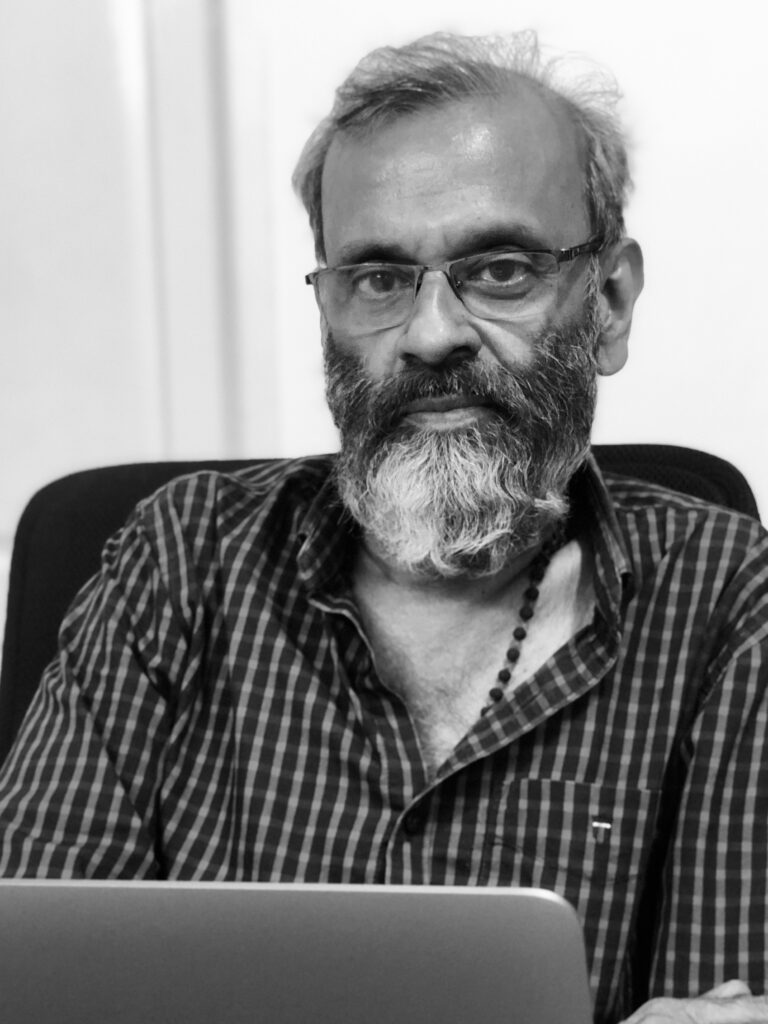WHO we ARE
In the spirit of collaboration, we open up our FAB stories so we better understand each other.
LEADERSHIP

My FAB Story
After finishing my college in 1991, by sheer providence, a friend of mine, Raj, who was working as a merchandiser with a small exporter got me some quality control work in night shifts to clear their production backlog and earning that ₹50 per shift not only taught me the value of money but also subtly got me interested in Fashion business.
Subsequently, the same friend introduced me to this French Gentleman Mr Christian Fabre who was starting his own buying house called Fashions International and was looking for a Quality Assurance personnel at that time and started working as a QC with this small organisation on 01st April 1991. Did I fool myself on that April Fools day into believing that I would be stuck with this beautiful and challenging industry for the rest of my life ! Glad I did.
That was the beginning of my journey and got to meet some extraordinarily talented people enroute as Buyers, product managers, designers from leading brands and retailers in Europe. And then the smart exporters fromLudhiana right down up to
Tirupur who nurtured me, imparted their vast knowledge, corrected me and pushed me to be better at all my undertakings.
I remember, once when I enquired a client whether my services were good, he bluntly stated that “He was not paying for good service but Excellent service”. This statement stuck to my head that excellence is not the destination but the journey itself.
“I’m not paying for
A blunt client
good service but excellent service”
From being the QC and learning the ropes of the industry, graduated into merchandising, then team head, profit center head and finally heading the organisation as CEO in 2011 just when the financial crisis hit the world.
Took it head on and managed the business through Covid in 2020 and finally ventured on my own with M/s FAB associates in Aug 2022.
At FAB associates, a profit sharing company, I see my role as a thought leader apart from managing its finances and marketing, wish to nurture an ecosystem of mutual trust, solution bound work, sharing of both knowledge and monetary results.
For a customer to buy a beautiful apparel which makes them look good, feel nice about themselves and showcase the aspirational value, it passes through a maze of network from the conception to fruition of the end product what we can call supply chain. That chain remains intact and gets the process going only through Trust in each other’s capability, knowledge and belief.
Trust, to me, is the very warp and weft of this industry. Right from clients, exporters and a million other small vendors like button suppliers, sewing thread manufacturers, interlining, printer, dyer, transportation etc and all will have to align well according to the norms stipulated by the client to get this one apparel across to the store for final sales. And we at FAB consider each and every end customer to be our client.

LEADERSHIP

My FAB Story
After spending almost a decade of my career in Saudi Arabia, I decided to come back & settle in India in 1992. Since last 30 years I am in this
industry and had the opportunity to interact with many knowledgeable and professionals in this field.
As far as my role is concerned, in addition to oversee the buying process, sourcing, product developments, production, social compliance & quality requirements etc. lot of emphasis to promote company’s culture, vision and its core value.
Though there are many incidents on the importance of transparency in business, I would like to share the one which really stands out.
While I was engaged in a garment fitting / trial testing process on a live model for a tight fitted Ladies over-dyed trousers for one of Europe’s leading streetwear brand in early 2000, we had a very embarrassing incident where we noticed a serious seam slippage issue that too at back crotch during our fitting session.
Seam slippage in a live trial. Who will take the responsibility and compensate?
Though buyer had approved the Pre-Production sample and the Exporter was about to commence the bulk production, fortunately during our routine pilot run/ pre-production trial we found this issue. Neither Exporter nor the
Fabric Mill are to be blamed for this as the fabric was approved during the Salesmen sampling stage by the buyer.
However, I called the Mill and the Exporter to our office and had a long telephone discussion with Buyer and was able to find an amicable solution where the Mill agreed to re-do the entire fabric all over again by increasing the reed-pick of the yarn whereby the seam slippage problem was arrested within the permissible level.
Both buyer and the exporter participated in the financial loss Mill incurred due to re-processing of the entire fabric.
Above clearly demonstrate getting the trust of your audience is the biggest among the benefits of transparency in business. By being open
about your policies and processes, you build trust among your customer, Exporter and for the organisation itself.

LEADERSHIP

My FAB Story
Right from my college days had a very strong passion for clothing/fashion and wished to be related with the garment industry but was not sure of where I was heading to. Thanks to my dear friend and mentor Mr Benhur to whom I owe a lot for where I am now.
Reflecting on my journey thus far, a couple of incidents stand out in my memory as vivid as though it had happened yesterday.
We used to work in a Northern town called Ludhiana, a city in the state of Punjab, a place well known for flat knit wear products and in layman terms pullovers or sweaters. I was stationed there to monitor production day in and out and surprisingly caught them knitting a 16 gauge sweater with white yarn instead of ecru yarn. I immediately rushed to the manager to stop the production stating the reason and not to continue knitting without the prior
approval of the client. He told me that these kind of colour differences are bound to happen in dyeing with a margin of 5 to 10% and was not giving green colour when the requirement is red ! I was flabbergasted at his reasoning and held firm to stop production making sense to him that Ecru is not white and it was totally another colour.
Colour differences are bound to happen in dyeing with a margin of 5 to 10% but using green when the requirement is red ?
We resolved the issue when the owner intervened and found that there were about 150 pieces which came in with the wrong colour and i may check with the client if it is acceptable for another destination and on approval from the client we shipped the same.
Second was a funny story about how fashion changes season after season according to which we need to not only adapt ourselves but to train and educate the exporter down to his packing team to adapt to the changing trends. Normally the garments are well ironed and presented neatly but this particular season the client had a requirement of crumpled/ crushed garments with a roll pack instead of a nearly ironed clean look. The packing team at the exporter couldn’t understand and kept offering fresh and well ironed clothes stating that the pieces were not commercial. We needed to show some pictures of what the client wishes to have and took some convincing to change their outlook on the product.
These anecdotes indicate that if we trust in our work and be sincere about it, a solution can be deciphered for every problem. My gut feeling says that the new journey with FAB associates will bring us many more laurels in recognition to what we are going to achieve in the future.

REACH US
CALL: +91 44 48513308
EMAIL: [email protected]
ADDRESS:
#10B, 1st Floor, 1st Cross Street, 1st Main Road, Ramappa Nagar, Perungudi, Chennai- 600 096, Tamilnadu, India.
IMAGE COURTESY : SHAYAN rti, Clem Onojeghuo, Chyntia Juls, Ardalan Hamedani, Alina Bordunova, Haley Lawrence, Cristofer Maximilian, Ayo Ogunseinde
